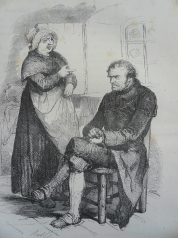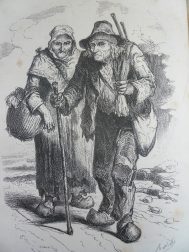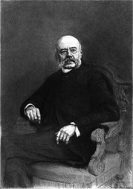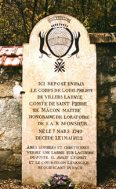
The Country Doctor
LA COMEDIE HUMAINE – Honoré de Balzac XIIIe volume des œuvres complètes de H. DE BALZAC by Veuve André HOUSSIAUX, éditeur, Hébert et Cie, Successeurs, 7, rue Perronet, 7 – Paris (1877)
Scenes from country life

Jacquotte and Monsieur Denassis

Father Moreau and his wife
THE COUNTRY DOCTOR
Balzac dedicates this work to his mother
Analysis of the work This novel, so often quoted, so often praised, has the double peculiarity of belonging neither to Balzac’s group of descriptive works nor to his group of philosophical works. A strange work by its very subject: Le Médecin de campagne is simply an account of a walk. The action, so to speak, is set in 1829. An officer travels to a village near Grenoble to meet a doctor, Dr. Benassis, to whom he wants to entrust his son. He’s heard this doctor praised, and he’s a bit of a celebrity. Dr. Benassis has become mayor of the village, and tells his visitor how he won the trust of the inhabitants after transforming the miserable village he had fled to in despair into a prosperous one. Then he showed him the results of his efforts by taking him on a tour of the country: this was the occasion for a number of meetings and interviews. In this pastoral tour, we witness some typical scenes of village life and see the conversions and improvements achieved: happy peasants, a newborn industry, bad subjects or outcasts turned into excellent citizens by Benassis, edifying examples, a poacher converted, a loan shark transformed, former Napoleonic soldiers holding a vigil in a group. The visitor is edified, tells Benassis the story of his life, and Benassis explains why he has taken on this mission. They part. Eight months later, the officer returned to the village, recalled by the death of Benassis, who was mourned by the whole valley. This didactic novel is a far cry from both Balzac’s realism and his novelistic devices. In this happy valley, Balzac’s peasants are no more real than those depicted in operettas. This is the main flaw in this slightly over-optimistic novel. On the other hand, the political ideas expressed by Balzac, while certainly inspiring interest and sympathy, do not sit well with realism and, above all, with the system of human application that commands the whole of La Comédie humaine. These are the events in Balzac’s life that explain Le Médecin de campagne, the birth of the project and the incidents that interrupted and delayed its execution. The idea for Le Médecin de campagne came to Balzac suddenly on September 29, 1832, and the novel went on sale on September 3, 1833. There’s nothing unusual about this delay. The novel’s publisher, Mame-Delaunay, was already the publisher of the first Scènes de la vie privée, and as such, he was well disposed towards Balzac. Nevertheless, Balzac did it in such a way as to infuriate his publisher, and Le Médecin de campagne became the subject of a lawsuit that infuriated Balzac and which he lost. The years 1831 and 1832 had been a time of political ambition for Balzac. Lettres sur Paris, published from October 1830 to March 1831 in Le Voleur, a newspaper founded by Emile de Girardin, followed by an Enquête sur la politique des deux ministères , had established him as a political chronicler. General elections had been held in July 1831. Balzac had the electoral colleges canvassed, in Fougères by his friend Pommereul, in Tours in memory of his father, a former deputy mayor, and in Cambrai by one of his disciples Samuel-Henri Berthoud. He didn’t show up. He felt he lacked the support of a political group. The leaders of the Legitimist party were well disposed towards him. Balzac gave pledges. In February 1832, he wrote an article in L’Artiste on the destruction of the monument to the Duc de Berry, and almost immediately joined the staff of Le Rénovateur, a newspaper founded by the Duc de Fitz-James and the publicist Laurentie. In June 1832, he had published an important Essay on the situation of the royalist party in Le Rénovateur, soon followed by an article on modern government, which the paper’s management found too categorical. Despite this, Balzac intended to run in Angoulême with the help of his Carraud friends who lived in the department.

Claire Clémence Henriette Claudine de Maillé de La Tour-Landry, Marquise de Castries.
It was at this point that the Marquise de Castries, niece of the Duc de Fitz-James, invited him to visit her in Aix-les-Bains, where she was staying at the time, as she was traveling a great deal. She was quite isolated, having had a public affair with the son of Chancellor Metternich, who had died the previous year. Balzac left to join her in August 1832. She was charming, even coquettish. Balzac was mistaken about this loving friendship. They remained on equivocal terms until the Duc de Fitz-James, the Marquise and one of their friends offered Balzac a place in their carriage for a trip to Italy. The invitation was flattering. Before leaving, Balzac felt authorized to go further than the kiss he called “a holy promise”. Balzac was humiliated and despairing. He abruptly gave up the trip. Painful weeks followed this disappointment. It took money to run this campaign. Balzac had committed all his resources to proving himself worthy of his social promotion, although the Marquise had tactfully indicated a modest inn. To cope with the trip to Italy, Balzac resorted to an expedient. In a letter dated September 30, 1832, he boldly announced to his publisher Mame that he was sending a friend ” a complete manuscript”, he stressed, entitled Le Médecin de campagne, to be published by Mame. In exchange, he asked for a 500-franc money order to be sent to Rome and another 500 francs to Naples, for a total of 1,000 francs, equivalent to 20,000/25,000 of our old francs, now around 3,050/3,800 euros, which Mame promptly delivered. This promptness was not rewarded with a manuscript. Mame had received a very attractive description of this phantom manuscript in his letter, so he had to make do with this mirage. He waited. At the end of January 1833, however, the printer received part of the manuscript, and began typesetting it. But this part of the manuscript didn’t correspond at all to the short novel in one volume that Balzac had described to Mame, and announced, on the contrary, a larger project that was to provide two in-8° volumes. Mame waited again. A second printing took place at the end of June 1833. But it was incomplete, the novel was not finished. Mame thought he’d been fooled: he summoned Balzac at the beginning of July. The trial was disastrous for Balzac. Mame mentioned not only Le Médecin de campagne, but also a treaty in which Balzac had promised him three works with fixed publication dates, none of which he had received. This aggravating circumstance seems to have convinced the court, which convicted Balzac. However, this legal offensive had a decisive effect on the editorial team. Balzac hurried to finish his novel, mainly in view of a coup de théâtre he believed would have an unstoppable effect. At the trial hearing on July 19, 1833, Balzac proudly presented the court with a complete two-volume copy of Le Médecin de campagne, stapled and ready to display in the bookseller’s window. This copy was composed of proof sheets, assembled to form a volume. The publisher had no trouble proving that none of these sheets had been printed in any quantity, and that this single copy, which he was delighted to have seen at last, was for the moment nothing but a hoax. The affair ended badly. Balzac, furious at being ordered by a court to supply Mame with the novel for which he had received payment, took his revenge by going to the printing works and destroying the lead lines on which his proofs had been made. A police superintendent was called in to assess the damage. Balzac appealed to a jury of honor, which ruled against him. Le Médecin de campagne having been put up for sale by Mame-Delaunay on September 3, 1833, the parties came to an agreement, which was signed before a notary on November 20, 1833. Balzac’s new publisher, Mme Veuve-Béchet, paid the damages and expenses, and Mame was satisfied.

Alfred Mame, printer-publisher
The specialists who studied the case of Le Médecin de campagne, in particular M. Bernard Guyon, followed and completed by Antony Pugh and Mme Rose Fortassier, were less severe than the court. They believe that Balzac had not invented an imaginary manuscript in order to obtain two 500-franc money orders, but that he really did have a first draft of Le Médecin de campagne which, however, was in no condition to be sent to the publisher. They believe that the manuscript fragments preserved in the Lovenjoul collection correspond to an original manuscript that could have been written in a few days following a visit to the Grande Chartreuse on September 23. The crisis of passion that followed the break-up with the Marquise de Castries would explain the interruption in writing: other circumstances, such as Balzac’s commitments to various publishers, would explain the delays and procrastination before arriving at a definitive text. In fact, these delays and procrastinations don’t explain the disparate nature of the work. Balzac’s definition of the term in his letter to Mame dated September 30, 1832 is quite curious. Primary objective: “To sell thousands of copies of a small in-8° volume such as Attala, Paul et Virgnie, Le Vicaire de Wakefield, Manon Lescaut…”. So, first and foremost, a bookshop business, as the variety of these references indicates. Then, an extravagant sentence: “I took theGospel and the Catechism, two works of great flow; and I made my own. “It’s strange that many critics have taken this commercial definition of theGospel and the Catechism as a profession of faith. Finally, Balzac announced that the novel would not be signed by him, under the pretext of other commitments. It will be a small volume of 126 to 220 pages in in-8° format, the smallest of all bookshop formats. There’s nothing mystical about this definition. Did Balzac intend to write an Imitation of Jesus Christ from the outset, to show “the Gospel in action”? Or, more modestly, to rival the famous Vicar of Wakefield, a commendable model indeed for its commercial celebrity? This original intention is uncertain. What is certain, however, is that a sudden burst of passion gave a completely different direction to the work that had begun. Upset by the Marquise de Castries’ “betrayal”, Balzac interrupts his peasant novel to describe in a Confession de Benassis the drama that has turned him into a kind of lay “Carthusian” who has taken a village as his cell. These violent pages, inspired by anger, are both an expression of romantic despair and the revenge of a writer who wants to publicly scourge the ungrateful woman who refused him. But at the same time, it’s a break in inspiration. The mobilization of anger no longer makes it possible to pursue the serene unfolding of the electoral prospectus: nor is it in keeping with the evangelical spirit or, failing that, with the peace of heart that enables Benassis to accomplish his mission. Balzac replaces this first Confession with the one we can read today, which gives a nobler cause to Benassis’s abdication, but above all gives him a duty of reparation and the appeasement that is necessary for the unity of the novel. From this point on, we can resume writing. But with what material? Here we find the contradictions of Scenes from Country Life. Balzac’s plan to describe “country life” dates back to 1831. Did he really know “the peasants”? If we are to believe the specialists who have studied the novel that bears this title, he was perfectly aware of their wiles, their lusts, their depravity through his stays at L’Isle-Adam with his old friend the Marquis de Villers-La-Faye, and also through his experience of the Tourange winegrowers. The latter, however, are not quite peasants: the gentleman Coudreux, a picturesque character in an 1831 sketch entitled Les deux amis, is a small landowner, not a peasant. A mediocre Scène de village (Village Scene ) written around the same time, and reprinted in part in Le Médecin de campagne, shows a naiveté that is disarming for anyone familiar with the greed and carelessness of the “nannies” to whom the Assistance Publique entrusted its unfortunate wards. This repertoire of “things seen” doesn’t quite fit in with the idyllic peasants of Le Médecin de campagne. For a long time, it was thought that Balzac had come across a village in Voreppe, near Grenoble, similar to the one in his novel, and even a Doctor Romme who had served as a model for him. Recent checks have destroyed this legend. Since then, it’s been hard to imagine in which Acadia Balzac found a peasantry so docile to the benefits he showered upon it. Balzac’s readings, on the other hand, provide clearer explanations. One book, in particular, gave him a real-life model he could follow closely. It was the life of Alsatian pastor Jean-Frédéric Oberlin, who died in 1826, that Balzac could find in a book by Madame Guizot, L’Ecolière, which he had printed in 1827. An even more recent biography of Oberlin was published in 1831. Oberlin, pastor of a poor village on the outskirts of Strasbourg, had transformed it into a prosperous town, helping craftsmen, founding a school and building a road. It was this career as a rural benefactor that Balzac had transposed. It was all the more likely to attract his attention as similar efforts had been successfully undertaken not far from L’Isle-Adam in a canton of the Oise department by the Duc de La Rochefoucauld-Liancourt.

Gravesite Louis-Philippe de Villers-la-Faye, Isle-Adam, friend of Balzac
In a recent study devoted to Le Médecin de campagne, Rose Fortassier mentions another reading, Rétif de La Bretonne’s La Vie de mon père . In his village in the Yonne, Edme Rétif had also acted as advisor and benefactor to the poor peasants of his village, and was rewarded, like Benassis, by the recognition of all. Perhaps it was the book’s idyllic description of peasant life and mentality that inspired Balzac’s imagination. Rétif de La Bretonne was a contemporary of Jean-Jacques Rousseau. There’s something of the Swiss bonhomie in these good dispositions that Benassis encounters among the inhabitants of his Alpine valley. The rural happiness of La Nouvelle Héloïse is a kind of background music that sets the tone for Le Médecin de campagne. These bookish influences may explain the picture of a happy valley so far removed from the realism of most of Balzac’s novels. Le Médecin de campagne is an ornate, “pourléché” book, one might say “a writer’s book”. There are even “bits” to show off the storyteller’s ease and talent. A naive account of Napoleon’s epic, told in a barn by a former soldier, is often cited as a masterpiece. It’s a “masterpiece” indeed: a kind of “competition piece”, a “solo”, whose main purpose is to provoke applause. These exhibitions of the writer are exceptional in Balzac. Balzac was particularly proud of the result. To his friend and confidante Zulma Carraud, he wrote on the eve of the sale on September 2, 1833: “You will read this magnificent work, and you will see how far I have gone. My goodness, I think I can die in peace, I have done a great thing for my country. This book is worth, in my opinion, more than laws and battles won.” This patent of civic-mindedness is, as we can see, rather far removed from Balzac’s ambitions when he wrote The Human Comedy. The contemporary press hardly shared this enthusiasm. Royalist newspapers were harsh, accusing Balzac of painting a Utopian kingdom. L’Echo de la Jeune France even spoke of a “childish castle in Spain”. Other assessments were less harsh, but generally negative. At the other end of the political spectrum, Karl Marx was adamant that The Country Doctor was a “Robinsonnade”. For other reasons, this desert island, where we discovered the joys of basket-making and the pride of the potter, gave Alain great pleasure: “The history of the basket-maker and the potter, the history of shoes and hats is always new to me”, he would say, and, in his enthusiasm, would evoke Plato’s Republic. Despite this reference, Alain, like Marx, rediscovered the freshness of Robinson Crusoe. This is also the opinion of Emmanuel Le Roy Ladurie, a specialist in rural history, albeit expressed very politely. In an introduction he was asked to write for Le Médecin de campagne, he marveled at the “multiplication of arable land gained over scrubland”, and relied on some fairy wand to explain the prosperity achieved in just a few months. These judgments by contemporaries and specialists contrast with the admiration of modern commentators. It is above all thanks to them that Le Médecin de campagne enjoys an eminent place among the novels that make up La Comédie humaine.
Source analysis: Preface from the 21st volume of La Comédie Humaine published by France Loisirs in 1987, based on the full text published under the auspices of the Société des Amis d’Honoré de Balzac, 45, rue de l’Abbé-Grégoire – 75006 Paris.
The story In 1829, Commandant Genestas arrived in a Dauphiné village where he met Dr. Benassis, who in ten years had transformed the miserable, backward village into a prosperous little town. The two men each have a secret that will only be revealed at the end of the story. Genestas takes up residence with Dr. Benassis for ten francs a day, on the pretext of treating old military wounds. The two men strike up a friendship, and the Major accompanies the doctor on his rounds. He then discovers how Benassis, who became mayor of the village, brought prosperity to the village by applying his theories. Through gigantic hydraulic works, he transformed an arid land into arable land where wheat and fruit trees could be planted. He also improved housing, created a small basketry and sawmill industry, and built a road linking the village to Grenoble. As a result, bakers, blacksmiths and a large number of craftsmen joined the population, which would experience a form of “luxury” five years later, with the installation of shops, tanneries and a butcher’s, as well as municipal structures: town hall, school. Finally, the two new friends tell each other the story of their lives: Major Genestas has a sick adopted son, Adrien, whom he wants to entrust to Doctor Benassis. But before entrusting his child to the doctor’s care, he needs to be sure of the nature and kindness of the practitioner. For his part, Benassis confides his secret to the Commandant: the enormous task he has accomplished for the village was for him a way of atonement. After the death of a young girl he seduced in his youth, and of the son he had with her, both abandoned by Benassis. Benassis, who dreamed of a noble marriage, will sacrifice mother and child to a life of misery that will kill them both. Following this tragedy, he decided to put his miserable existence at the service of others.
Source story : Wikipedia
The characters Docteur Benassis: (1783-1829) physician. During his lifetime, he had a natural son with a certain Agathe, who died when he was still very young. Pierre-Joseph Genestas: A soldier born in 1779, he married a Polish woman, Judith (1795-1814). He recognized the son she had had with Renard, Adrien, born in 1813. Adrien Genestas: Son of Judith and Renard. Recognized and taken in by his stepfather Pierre-Joseph Genestas. Renard: Wholesale grocer whose non-commissioned officer son was killed in 1813. He is Adrien’s grandfather.
Source genealogy of characters: Félicien Marceau “Balzac et son monde” Gallimard
No Comments